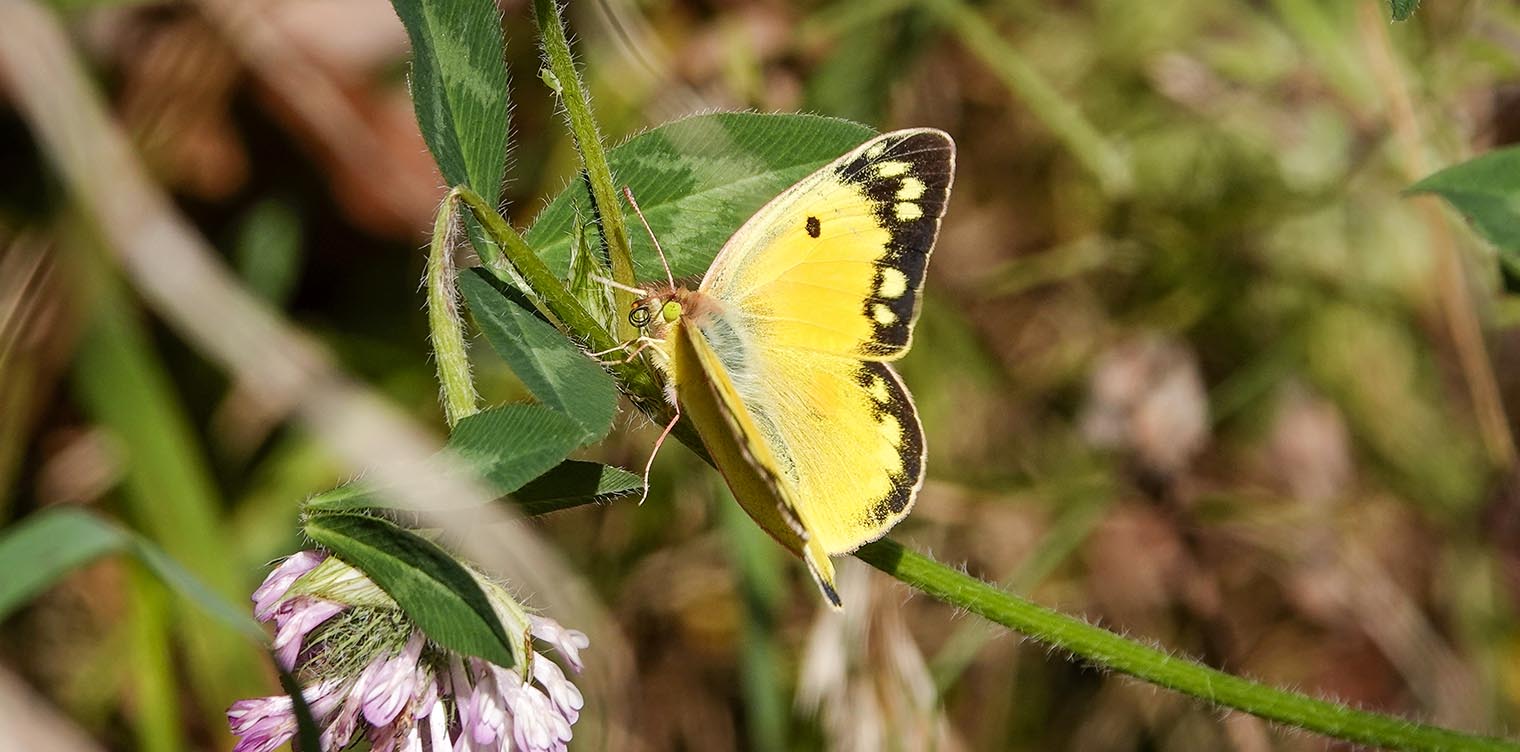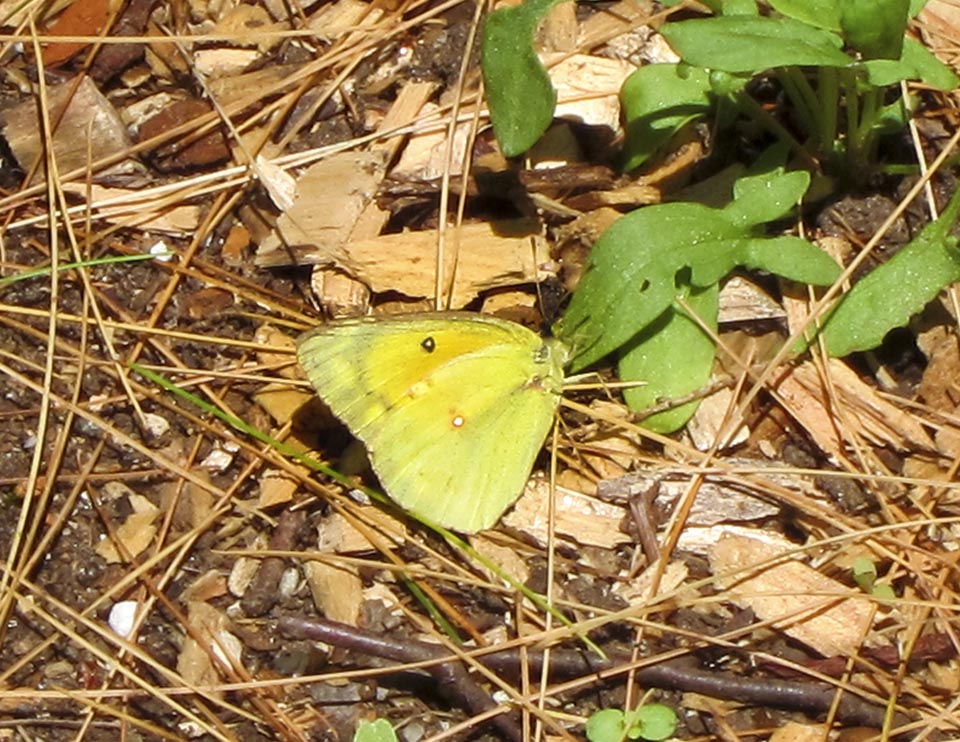Butterflies of the Adirondacks:
Orange Sulphur (Colias eurytheme)

The Orange Sulphur (Colias eurytheme) is a medium-sized butterfly seen in the Adirondack Mountains of upstate New York in summer. It is also known as the Alfalfa Butterfly [1] [2] – a reference to the preferred host plant.
The Orange Sulphur is one of three members of the Colias genus found in the Adirondack Park. The others are Clouded Sulphur and Pink-edged Sulphur. Butterflies in this genus are usually some shade of yellow, orange, or white. [3] Seen from above, they have black borders, solid in males with pale spots in females. All of our sulphurs usually perch with closed wings, which complicates identification.
Most sources agree that the Orange Sulphur colonized the east from its previously more western range, but they disagree on the timing. Some sources indicate that this butterfly first colonized the eastern United States in the 1930s. [4] Other sources suggest that the Orange Sulphur colonized the region east of the Appalachians after 1890. [5]

Orange Sulphur: Identification
In terms of color, the Orange Sulphur is quite variable. [6] [7] From above, the male may be bright orange with a wide black border or yellow with an orange flush in the middle of the wings. The orange is most evident in flight. [8] The female may be yellow with an irregular black border. Just to confuse things further, some females are white. [9]
This butterfly, like other Sulphurs, almost always perches with its wings closed, [10] [11] which means that most of our views of the Orange are from below. [12] Seen from below, the Orange Sulphur is more yellow than orange, resembling a Clouded Sulphur. [13] The Orange Sulphur is said to be somewhat larger, [14] [15] with wider dark wing margins. [16] It has a red-rimmed silver spot on the hind wing and a spot above it. [17] Both wings have a pink fringe. [18] The average wing span of the Orange Sulphur is 1.9 inches. [19]
Orange Sulphur: Life History
Male Orange Sulphurs patrol back and forth from mid-morning to mid-afternoon, with courtship and mating occurring primarily at midday. [20] Their courship does not involve elaborate displays. [21] The females lay their eggs singly on host plant leaves, which includes leaves from alfalfa, white clover, and white sweet clover. [22] The eggs are whitish in color, [23] turning crimson in a few days. [24]
Orange Sulphur caterpillars feed, usually at night, on various species in the pea family. [25] The caterpillars can cause considerable damage in alfalfa and clover fields, where they are considered to be an agricultural pest. [26] [27] Adults feed on nectar from a variety of flowers including goldenrod, aster, milkweed and dandelion. [28] [29]
Orange Sulphur: Habitat and Range
The Orange Sulphur is one of the most widespread butterflies in North America, ranging from southern Canada to central Mexico. [30] This butterfly is described as an adaptable generalist. [31] Its habitat includes nearly any open space, including open meadows and fields (particularly alfalfa fields), roadsides, vacant lots, and suburban areas. [32] [33] [34] [35]
Orange Sulphur: Flight
The flight period of Orange Sulphurs, as with all butterflies, varies with region and shifts from year to year. Most sources agree that this species has two to three flights in the north, with individuals flying from June through October. [36]
- Orange Sulphurs reportedly are common to abundant in Massachusetts. There are three overlapping broods, with Orange Sulphurs seen from mid-April to October. [37] [38]
- In Vermont, the Orange Sulphur is said to be very common, with two to three broods. The flight period is lengthy, starting in Mid-May and continuing through mid-November. [39]
- In Wisconsin, Orange Sulphurs have two to three broods, with individuals found from early spring until late fall. This species is said to be very common, but not as common Clouded Sulphurs. [40]
- In the New York City area of New York State the flight period is from April through late October, with most sightings in July through mid-September. [41]
- Orange Sulphurs are fairly common in Canada, where there are two or three broods. Adults are on the wing from May into November in southern Canada. [42]
The flight period and abundance of the Orange Sulphur within the Adirondack Park can only be roughly estimated, based mainly on the very limited number of verified sightings on Butterflies and Moths of North America (BAMONA) and reported observations on iNaturalist.
- The advantage of iNaturalist is that it is a popular citizen science web site that attracts many observers, in part because it covers both plants and animals and in part because the process of submitting an observation is very easy. The disadvantage is that an individual observation can achieve "research-grade" status by being confirmed by the observer and one additional individual, who may or may not have expertise in that particular taxa.
- The advantage of BAMONA is that sightings are verified by regional specialists who are recognized experts. The disadvantage is that there are fewer sighting records for most species, partly because the site covers only butterflies and moths and partly because the process of submitting a sighting is more complicated.
- Both data sets share a common problem of citizen science: reported trends may reflect trends in the number of observers and their willingness to submit reports, not the abundance of the butterfly in question. In addition, the Orange Sulphur is quite similar in appearance to both the Clouded Sulphur and the Pink-edged Sulphur; it is very difficult in many cases to distinguish among these three species, especially if the observer does not have a clear view of the specimen. As a result, the number of recorded sightings may not reflect this species' abundance.
With these caveats in mind, it appears that Orange Sulphurs are relatively uncommon in the Adirondack region. Those that are seen in our region fly throughout the summer into early fall.
- The Orange Sulphur was present throughout much of the summer in the Paul Smiths VIC Native Species Butterfly House. [43] In the Butterfly House, the Orange Sulphur was usually seen perching with closed wings on the ground on a bed of pine needles.
- Most of the BAMONA-verified sightings for Orange Sulphurs in the Adirondack Park counties suggest that this species is not commonly seen within the Blue Line. There were only 11 confirmed sightings in the Adirondack Park counties. These were mainly in June and July, with a few August and September sightings. [44]
- The pattern of research-grade iNaturalist observations indicates a similar pattern. There have been very few observations of Orange Sulphurs within the Blue Line. As of late October 2021, there were only nine observations (four of which were research-grade). [45] This compares to 136 observations of Clouded Sulphurs [46] and 21 observations of Pink-edged Sulphurs. [47] The most frequently observed butterfly in the Blue Line is the Monarch, with 555 observations. [48] The few observations of Orange Sulphurs within the Blue Line included sightings from June through late October.
References
- Susan Grimm Hanley. Interpretive Naturalist, Paul Smith's College Native Species Butterfly House. Species Logbooks.
- Butterflies and Moths of North American. Species Profile. Orange Sulphur. Colias eurytheme. Retrieved 21 October 2021.
- Butterflies and Moths of North American. Sighting records. Orange Sulphur. Colias eurytheme: 6/25/2005, 6/29/2006, 6/23/2012, 6/28/2012, 6/30/2012, 7/28/2012, 8/9/2015, 8/9/2015, 9/23/2017, 8/20/2020, 10/20/2021. Retrieved 21 October 2021.
- iNaturalist. Clouded Yellows. Genus Colias. Retrieved 22 October 2021.
- iNaturalist. Species Account. Orange Sulphur. Colias eurytheme. Retrieved 22 October 2021.
- iNaturalist. Adirondack Park Observations. Orange Sulphur. Colias eurytheme. Retrieved 22 October 2021.
- iNaturalist. Adirondack Park Observations. Clouded Sulphur. Colias philodice. Retrieved 22 October 2021.
- iNaturalist. Adirondack Park Observations. Pink-edged Sulphur. Colias interior. Retrieved 22 October 2021.
- iNaturalist. Adirondack Park Observations. Monarch. Danaus plexippus. Retrieved 22 October 2021.
- Government of Canada. Canadian Biodiversity Information Facility. SpeciesBank. Retrieved 21 October 2021.
- Massachusetts Butterfly Club. Massachusetts Butterfly Species List. Orange Sulphur. Colias eurytheme. Retrieved 22 October 2021.
- Massachusetts Audubon. Butterfly Atlas Species Accounts. Orange Sulphur. Colias eurytheme. Retrieved 22 October 2021.
- McFarland, Kent P. and Bryan Pfeiffer. Vermont Butterfly Survey. Vermont Center for Ecostudies – Vermont Atlas of Life. Orange Sulphur. Colias eurytheme. Retrieved 22 October 2021.
- Wisconsin Butterflies. Orange Sulphur. Colias eurytheme. Retrieved 22 October 2021.
- Iowa State University. Department of Entomology. BugGuide. Orange Sulphur. Colias eurytheme. Retrieved 22 October 2021.
- University of Michigan. Animal Diversity Web.
- National Audubon Society. Field Guide to Butterflies (New York: Alfred A. Knopf, 1981), pp. 372-273.
- Jim P. Brock and Kenn Kaufman. Kaufman Field Guide to Butterflies of North America (Houghton Mifflin, 2003), pp. 60-61.
- Paul A. Opler. A Field Guide to Eastern Butterflies (The Peterson Field Guide Series, Houghton Mifflin Company, 1992,1998), pp. 46-47, 60-61, 155-156.
- Jeffrey Glassberg. Butterflies of North America (Michael Friedman Publishing, 2002), pp. 76-77.
- James A. Scott. The Butterflies of North America. A Natural History and Field Guide (Stanford University Press, 1986), pp. 196-198.
- Jeffrey Glassberg. Butterflies through Binoculars. The East. A Field Guide to the Butterflies of Eastern North America (Oxford University Press, 1999), p. 57, Plates 6 & 8.
- Paul A. Opler and George O. Krizek. Butterflies East of the Great Plains: An Illustrated Natural History (The Johns Hopkins University Press, 1984), pp. 65-66, Plate 7.
- Rick Cech and Guy Tudor. Butterflies of the East Coast. An Observer's Guide (Princeton University Press, 2005), p. 138.
- David Carter. Butterflies and Moths (Dorling Kindersley, Inc., 1992), p. 72.
